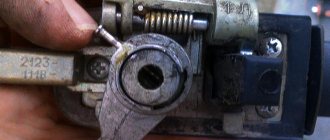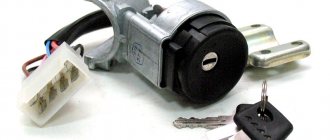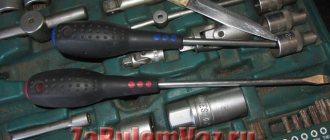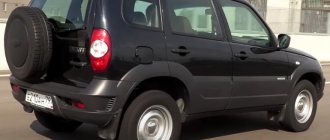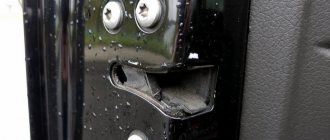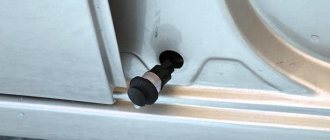What is the door trim of the Niva Chevrolet
As a rule, the casing in any car is made of plastic . It hides the inner parts of the doors in the car. There may be other decorative elements on top of the plastic parts.
The product has several main functions:
- Installation of speakers, storage of small items inside special pockets.
- Reduced external noise levels inside the cabin.
- Place for mounting a handle that opens and closes the door.
- Creating an attractive appearance and a certain style.
- Hiding the metal base of a Niva Chevrolet, how to remove the front door trim - everyone can figure it out.
Lada 4×Urban (new type skins)
There are slight differences in the process of dismantling the door trim of the new model (different door handle and location of fastening screws).
- Remove the door handle: take out the plug, prying it off with a screwdriver, and then unscrew the two fastening screws.
- Remove the inner handle trim: pry it off with a screwdriver.
- (For rear door trim) Remove the window handle: remove the latch by prying it with a screwdriver between the latch and the washer.
- Unscrew the door .
- Unscrew the screws securing the casing (4 on top under the plugs and 3 on the bottom).
- Remove the door trim by unclipping the rivets around the perimeter.
Have you ever had to remove door trim on a Lada 4x4 with your own hands? Let us remind you that in order to maintain the integrity of the plastic pistons (clips), it is recommended to use a special kit for disassembling the interior (clips) during dismantling. Look in the Aliexpress catalog
Key words: 4x4 doors
The process of dismantling the front door trim from a Chevrolet Niva
There are various reasons why there is a need to carry out such work . For example, when repairing a door mechanism or installing additional speakers. The work is easy to do yourself, you just need to spend some time studying the nuances.
The procedure is not at all complicated.
- The inner handle has two plugs; under them there are mounting screws for this design. To remove the plugs, just poke at the structure with a sharp object.
- Use a screwdriver to unscrew the screws from the armrest, and the latter is removed.
- Three screws hold a special pocket on the plastic, with which you can store various items inside. The screws themselves are located at the bottom.
- The plastic cover of the handle for opening the door is dismantled next. The handle is unscrewed, then the screw inside is removed. Remove the decorative trim by pulling part of the part towards you. The main thing is that the trunk is not damaged.
After this stage, everything is ready to get rid of the outer skin . Plastic dowels hold the product to the base. The keys are removed from the holes in the door sequentially - they are passed along the entire perimeter with tools. After this, there should be no problems with removing the trim in front.
Chevrolet Niva “Project N” › Logbook › Taping the rear (fifth) door.
A little background.
I already had experience in car sizing. I glued my VAZ 2113 back in 2009 (but never finished it). True, then the materials were different and the effect from them was not so good. But at that moment I didn’t know this. For a very long time I did not recognize self-adhesive vibration material, preferring hair dryer. But as you know, progress does not stand still! When I bought a Chevrolet NIVA, I planned to tape only the trunk and front doors (while listening to music). At that time, I was already familiar with the professionals in their field, “Bass Zone,” and I planned to entrust my car to them. Friends who know me well dissuaded me from this idea, citing the fact that I would have to redo everything later anyway. In general, I decided to glue it myself and not stop at the doors with the trunk. After talking with a person very competent in noise and vibration insulation, I realized that I knew absolutely nothing. He helped me a lot with the selection and amount of material needed for the entire car. He also told a lot, explained and gave a lot of practical advice. The material was chosen by “Shumoff”. I started with the back (fifth) door. Having dismantled the door, I was slightly horrified by what I saw. The wires hung like snot and were practically not secured.
Got the wiring in order. Material: fabric insulating tape “tesa”, reinforced tape “tesa” and “Shumoff”Specific.
And I started gluing the inside of the door. The first layer was glued with vibration-absorbing, multi-layer, self-adhesive material “Mix F” with a thickness of 4.5 mm. I tried to cover as much of the inside of the door as possible. This was very difficult due to the welded spare wheel mounting amplifier.
Next, on top of the vibration-absorbing material, I glued self-adhesive noise-absorbing material “Comfort 6” with a thickness of 6 mm.
Then it was the turn of the outer part of the door; the first step was to close the technological holes. I used sheet aluminum 0.4 mm thick. and “Mix F” for small holes. The aluminum was secured using double-sided, self-adhesive “tesa” mounting tape.
On top of the plugged technological holes, I glued vibration-absorbing material “M3” with a thickness of 3 mm. “Comfort 3” (self-adhesive sealing material) was glued along the perimeter of the lower part of the door, where the trim fits.
The skin was degreased and glued with self-adhesive relief material “Germeton A15” 15 mm thick. Do not forget to degrease the surface before each material! I inserted clips into the trim and assembled the door. I was very pleased with the result, the sound of the door when closing became dull, and I began to make less effort to close the door. The door became heavier, but not by much. I once stopped by the studio to visit a person competent in noise and vibration insulation, drink tea, and talk about the work done. To which he says to me: “Well, let’s go see what you stuck there.” He immediately pointed out all the disadvantages to me. He also pointed out the unrolled material, but I said that it was rolled and explained how I did it. At the next meeting, I took with me a mock-up, in the form of two pieces of vibration material glued and rolled onto the glass in two different ways (one with a roller, and the other with mine). After looking and turning the layout in my hands, I received the answer that both materials were well rolled. An attempt to peel off the material failed; only the foil came off. “Of course, your version of rolling for car audio is better, since it preserves the entire relief of the material and subsequently refracts (rather than reflects) the sound and dampens it in sound insulation. It’s just that your method takes a long time, and the roller saves a lot of time. Well done, it’s nice to see when people develop and don’t stand still doing everything according to a template.” Keeping in mind the shortcomings and the indicated disadvantages that haunted me. Namely, this is not a weighted door trim, not glued plastic, lack of a plastic seal and poor fixation of the wiring. I decided to fix everything. While disassembling the door, there was a small problem: several fasteners came off the trim, and the trim itself was torn (Having visited all the auto shops and car markets in Samara, the original trim was never found, so I had to order it. I started gluing the plastic.
The first layer was self-adhesive vibration-absorbing material “M2” with a thickness of 2 mm. In the places where the plastic contacts each other, I pasted “Comfort 3”.
The second layer was applied with self-adhesive sealing material “Bitolon 5” 5 mm thick.
“Comfort 3” was glued around the perimeter of the door, in the areas where the trim and plastic parts meet. Also, using reinforced tape “tesa”, the wiring was completely fixed. To more securely fix the casing, new clips were purchased, consisting of two parts. Once I pick it up and glue the casing, I’ll add a photo.
Finally, I took the factory trim of the fifth door. As I wrote earlier, I was unable to find the original skin (Once talking to a friend on the phone who works at F-Design, I shared with him my unsuccessful search for the skin. To which he answered me: “It’s not surprising, because the manufacturer works with the plant will never be distracted by small retail sales. Since the company is working at the limit and has difficulty coping with large volumes of the plant, as well as deadlines." After which he promised to help me. A month of waiting and I took the casing. I was very surprised by it new design. It's nice to know that the plant is constantly improving the quality of its products, replacing components with better ones. In general, you can see the difference in the photo.
Old casing that I ruined during disassembly. As you can see in the photo, the places for attaching the clips are set on some kind of hot-melt adhesive. And as practice shows, the fastening is not very reliable.
New casing. The clip fastenings are built into the skin itself at the initial stage of its production. Added weather stripping and stronger reinforcement to the top right side. I started gluing the casing.
I removed the sticker and degreased the entire surface. Then, I glued self-adhesive vibration-absorbing material “M2” with a thickness of 2 mm.
Self-adhesive noise-absorbing material “Germeton 7” was glued on top of the vibration. After which I had difficulty assembling the door.
When installing the trim, I was very upset by the vaunted two-part clips! It is almost impossible to get them into the holes. I had to target each one and after I made sure that all the clips matched, I began to drive them in, and they broke (In the end, all the clips broke. By the way, they cost ten times more than regular ones, but in reality they are simply terrible. So no Do not buy these clips under any circumstances! After removing the fragments of the clips, I installed regular ones and safely assembled the door.
The process of removing the trim from the rear door
Painting, straightening, any welding work - these are situations in which it is necessary to remove the rear door . Or this is done in the case when the presence of such an element interferes with the organization of any other work.
First, prepare the necessary set of tools. Then they move on to the actions themselves, the sequence of which is standard :
- The minus terminal is disconnected from the battery to de-energize the entire vehicle. The driver's steering wheel is no exception. The bolts securing the door opening limiter are unscrewed with a ten-point socket.
- Rubber protection elements are removed from the wires that fit under the door. By squeezing the plastic clamp, the pads are disconnected from each other.
The retaining clips are removed from the door hinges using a flathead screwdriver . It is quite easy to pry the indicated space with it.
The door must be pulled up along the axes with a hinge to be removed from its place . At this stage, the repair work can be considered almost complete. Installation is in reverse order. The door mechanism is checked for functionality.
Niva Chevrolet rear door repair
Dismantling and assembling the rear door of a Niva Chevrolet car
We prepare the car for the job
Remove the negative terminal of the battery.
To complete the task you will need tools: a set of screwdrivers, a 8mm head.
Using a Phillips screwdriver, unscrew the self-tapping screw securing the inner handle lining
Removing the handle trim
Squeeze the protrusions of the latch
And remove the door lock button
Insert a screwdriver between the socket and the window handle trim
Move the handle trim
Removing the window handle
Using a Phillips screwdriver, unscrew the self-tapping screw securing the upholstery installed in the armrest niche
Using a Phillips screwdriver, unscrew the two self-tapping screws securing the upholstery from the bottom.
We remove the lower part of the upholstery, removing the six pistons for its fastening from the holes in the door panel
Removing the door trim
Trim tuning: different solutions
Tuning of the interior parts is carried out to increase the comfort of passengers and the driver . The modern market offers many solutions, with different characteristics and features.
Interior insulation: what materials are used
The most common solutions:
- Madeleine. A type of seal with a fabric base.
- Bitoplast. Prevents so-called skips. It is distinguished by the presence of a sticky layer that simplifies fixation.
- Stizol. Suitable not only as a sound insulator, but also to contain heat inside.
- Isotone. It has excellent performance in absorbing sound waves.
- Vibroplast. Increased elasticity is the main characteristic due to which the base has become so widespread.
- Vizomat. Self-adhesive substance capable of absorbing vibrations of any type. The basis of impregnation is bitumen mastic. A closed car provides complete protection.
Reupholstering doors and panels with glue
Reupholstering complex surfaces raises the most questions , even among experienced craftsmen.
But it would be a good idea to familiarize yourself with the main nuances :
- First prepare the surface. Washing, sanding and degreasing are mandatory steps. Then the adhesion of materials increases, they adhere to each other faster and better. Special substances will help cope with degreasing.
- Next, glue is applied to the working surfaces and the material used. Applying with a brush helps with areas that have a lot of unevenness.
- Heating with a hair dryer promotes faster and better adhesion. Materials become more elastic.
Tips for using sewing machines
General recommendations for better results:
- The surface and elements are prepared for further use of the pattern.
- Paper is used as a blank, where the elements are transferred.
- Lines along which further work is carried out are marked on the material.
- The stitching of the material is carried out along the lines outlined in advance. Afterwards everything is stitched.
- Excess parts are carefully trimmed.
- The adhesive composition is applied to the reverse side. After which the products are connected to each other.
- The main thing is to protect the front surface from glue. Removing it does not cause any trouble.
Removing the upholstery of a Chevrolet Niva car
Removing the body floor trim is shown in Fig. 8-78.
Remove covers 2 and 3 from the transfer case lever and gear lever. Unscrew the self-tapping screws 1 and remove the floor tunnel lining 4. Unscrew the screws and remove the front 9 and rear 5 floor sill linings. If necessary, remove the floor mat 8, front 6 and rear trunk mats 7. Removal of body upholstery is shown in Fig. 8-79.
Unscrew the self-tapping screws 2 and remove the lower 1 and upper 20 trim of the center pillar. Press out the 4 windshield pillar trims and remove the trims. Remove shelf 15 from the trunk. Remove the trunk trim 12. Unscrew the self-tapping screws and remove the rear side trim. Remove the upholstery 17 of the arch and trunk. Remove the front trim insert 3 and the front roof trim insert 5. Unscrew the fastening screws and remove the roof lining.
Chevrolet Niva, 2010
Participate in the discussion can only registered users.
Sources:
https://avsu-pitanie.ru/info/kak-snjat-obshivku-dveri-bagazhnika-shevrole-niva/ https://555-shop.ru/remont/kak-snyat-obshivku-zadnej-dveri-niva- shevrole.html https://avtoarh.ru/Chevrolet/snyatie-i-ustanovka-oblitsovki-bagazhnika-Chevrolet-niva.html
How to disassemble the trunk door of a Niva Chevrolet
In this article we will look at disassembling the tailgate of a Niva Chevrolet car.
To complete the task you need the following keys: TORX key T20, T40, a set of screwdrivers, a key for 8, 10, 13, heads for 8, 13.
Removing the tailgate trim
Use a Phillips screwdriver to unscrew the four screws securing the top door trim
Removing the top door trim
We remove the plug from the right trim by prying it with a flat screwdriver
Unscrew the self-tapping screw securing the right trim using a TORX T20 wrench.
We also unscrew the self-tapping screw of the left trim
Unscrew the two self-tapping screws securing the right trim with a Phillips screwdriver
Removing the right door trim
Using a Phillips screwdriver, unscrew the self-tapping screw securing the left trim
Removing the left door trim
Unscrew the lid of the tailgate glass washer reservoir
Remove the rubber lining of the tank neck
Use a screwdriver to pry off the door trim from the inner door panel
Place a piece of rag under the screwdriver to avoid damaging the paint.
We separate the upholstery, starting from the door lock and further, moving along the perimeter.
We remove the upholstery. There are 12 pistons on the upholstery.
If the pistons are damaged, replace them with new ones.
Body types
The type of trunk itself and the features of the lining are determined by its design. There are several types of body. Their design is almost the same regardless of the model - Qashqai, Granta Liftback, Opel Antara, Lada.
- The sedan is the most common option. A closed body in which the trunk is separated from the passenger compartment and does not have a lift-up door.
- Hatchback is distinguished by a shortened rear overhang, and the trunk is closed by a door in the rear wall.
- A station wagon is a more voluminous, bulky body. Here the luggage compartment is integral with the interior, and its lid is extended to the rear clearance. The volume of the luggage section becomes noticeably larger.
- Liftback is an average solution between a hatchback and a station wagon. Unlike the first, the liftback - for example, the Granta Liftback, has a longer rear overhang. In this case, the door can be sloping, like a station wagon, or more stepped, like a sedan.
Luggage compartment Grant Liftback
- Coupe is a closed body, the luggage section is fenced off from the passenger compartment, there is no door. The volume of the section in this case does not exceed 0.93 cubic meters. m.
- Convertible is a model with a different type of convertible top. There is no luggage compartment.
- Roadster is a sports version without a roof or with a hard roof.
- Targa is a variant of a sports car with a roll bar behind the seats and a removable roof.
- A limousine is similar in design to a sedan, but with an elongated body and a rigid screen between the driver and passenger compartments. The luggage compartment is like a sedan.
Related article: How to properly paint timber yourself
Limousine
- Stretch – has an elongated interior due to an additional section between the rear and front seats.
- The van is a two-seater version with a closed body. The luggage section has its own door.
- An SUV is a closed model with a luggage compartment similar to a station wagon. The car has increased cross-country ability.
SUV
How to repair the luggage compartment of a Nissan car
In fact, it all depends on the design and the value of the finish. Usually it performs a purely decorative function.
- For example, it takes literally 5 minutes to remove the Qashqai trunk door trim. To do this, you need to unscrew the self-tapping screw in the door opening handle. Then the latches are released at the plastic joining areas in the compartment. Then you can remove the trim from the pistons. Installing the cover in the trunk takes the same amount of time.
Nissan manufacturers prefer the simplest possible engineering solutions in matters of finishing, and therefore replacement of the trim in almost all Nissan models, not only Qashqai, but also Sentra, Tiana, Terrano, is carried out according to the same principle.
Nissan car trunk
How to remove trim from a Chevrolet Niva
The trunk trim of the Chevrolet Niva is also a purely decorative detail. The material washes well, so it is quite possible to remove it for a while to wash it if, for example, dry cleaning is not available.
- Having opened the trunk door, use a Phillips screwdriver to unscrew the top screws on the decorative frame.
- Remove the decorative plugs on the lower parts of the frame. Unscrew the screws under them.
- Unscrew and remove the washer fluid reservoir cap. Then remove the neck located under the plug.
- Use a flat screwdriver to pry up the trim around the perimeter and carefully remove it. The plastic retaining pins are also removed along with the casing. The latter break during this procedure, so you will have to purchase new parts. The pistons are universal and any are suitable for the Chevrolet Niva.
How to remove the trunk trim of a Granta Liftback
For Lada - both station wagon and hatchback, the procedure for repairs is the same. Granta Liftback is no exception.
- Open the luggage compartment, find a plastic internal handle and use a Phillips screwdriver with a thick blade to unscrew the fastening bolts.
- Then use a flat screwdriver to pull out the retaining pins around the perimeter of the trunk. In this case, use a screwdriver to slightly pry up the finish itself.
- After the bolts are removed, remove the casing from the latches - the latter are placed in the upper part, where the lock is located.
- Remove the entire casing. Now it can be cleaned or replaced with another model if there is a lot of wear.
Related article: DIY bookcase: selection of materials, procurement of parts, installation
Tiguan luggage compartment repair
On Volkswagens the procedure is slightly different.
The trunk trim of a Tiguan, for example, is removed as follows.
- First, use a hex wrench to unscrew the side clips. Then the lining is separated from the eyes to fix the mesh. In this case, you need to apply force.
- The casing is then pulled off from the top clips.
- Unscrew the screw from the top, the side frame screws and from the folding hook.
- Then the casing is separated - with force - around the perimeter, releasing the remaining clips.
- The fixation in the Tiguan is quite rigid, so it is recommended to remove the casing one at a time: first from the left, then from the right side.
The video demonstrates the removal of the trim on different models: Tiguan, Opel Antara, Qashqai.
The best posts
Car repair involves not only replacing or restoring structural parts, but also finishing. And sometimes the latter poses no less difficulties. Removing the rear door trim seems simple, but there are some nuances here too.
Trunk door
Removing and installing the tailgate lock
Disconnect the negative terminal of the battery.
Remove the tailgate trim as described above.
Disconnect the wiring connectors for the trunk light switch and the electric drive.
Use a flat-head screwdriver to pry and disconnect the lock switch rod end from the door handle
Use a screwdriver to pry the door handle rod off the lock lever.
Use a Phillips screwdriver to unscrew the three screws securing the lock to the door.
Using a Phillips screwdriver, unscrew the two screws
Removing the electric locking drive
Install the lock in reverse order
Body types
The type of trunk itself and the features of the lining are determined by its design. There are several types of body. Their design is almost the same regardless of the model - Qashqai, Granta Liftback, Opel Antara, Lada.
- The sedan is the most common option. A closed body in which the trunk is separated from the passenger compartment and does not have a lift-up door.
- Hatchback is distinguished by a shortened rear overhang, and the trunk is closed by a door in the rear wall.
- A station wagon is a more voluminous, bulky body. Here the luggage compartment is integral with the interior, and its lid is extended to the rear clearance. The volume of the luggage section becomes noticeably larger.
- Liftback is an average solution between a hatchback and a station wagon. Unlike the first, the liftback - for example, the Granta Liftback, has a longer rear overhang. In this case, the door can be sloping, like a station wagon, or more stepped, like a sedan.
Luggage compartment Grant Liftback
- Coupe is a closed body, the luggage section is fenced off from the passenger compartment, there is no door. The volume of the section in this case does not exceed 0.93 cubic meters. m.
- Convertible is a model with a different type of convertible top. There is no luggage compartment.
- Roadster is a sports version without a roof or with a hard roof.
- Targa is a variant of a sports car with a roll bar behind the seats and a removable roof.
- A limousine is similar in design to a sedan, but with an elongated body and a rigid screen between the driver and passenger compartments. The luggage compartment is like a sedan.
Limousine
- Stretch – has an elongated interior due to an additional section between the rear and front seats.
- The van is a two-seater version with a closed body. The luggage section has its own door.
- An SUV is a closed model with a luggage compartment similar to a station wagon. The car has increased cross-country ability.
SUV
How to repair the luggage compartment of a Nissan car
In fact, it all depends on the design and the value of the finish. Usually it performs a purely decorative function.
- For example, it takes literally 5 minutes to remove the Qashqai trunk door trim. To do this, you need to unscrew the self-tapping screw in the door opening handle. Then the latches are released at the plastic joining areas in the compartment. Then you can remove the trim from the pistons. Installing the cover in the trunk takes the same amount of time.
Nissan manufacturers prefer the simplest possible engineering solutions in matters of finishing, and therefore replacement of the trim in almost all Nissan models, not only Qashqai, but also Sentra, Tiana, Terrano, is carried out according to the same principle.
Nissan car trunk
How to remove trim from a Chevrolet Niva
The trunk trim of the Chevrolet Niva is also a purely decorative detail. The material washes well, so it is quite possible to remove it for a while to wash it if, for example, dry cleaning is not available.
- Having opened the trunk door, use a Phillips screwdriver to unscrew the top screws on the decorative frame.
- Remove the decorative plugs on the lower parts of the frame. Unscrew the screws under them.
- Unscrew and remove the washer fluid reservoir cap. Then remove the neck located under the plug.
- Use a flat screwdriver to pry up the trim around the perimeter and carefully remove it. The plastic retaining pins are also removed along with the casing. The latter break during this procedure, so you will have to purchase new parts. The pistons are universal and any are suitable for the Chevrolet Niva.
How to remove the trunk trim of a Granta Liftback
For Lada - both station wagon and hatchback, the procedure for repairs is the same. Granta Liftback is no exception.
- Open the luggage compartment, find a plastic internal handle and use a Phillips screwdriver with a thick blade to unscrew the fastening bolts.
- Then use a flat screwdriver to pull out the retaining pins around the perimeter of the trunk. In this case, use a screwdriver to slightly pry up the finish itself.
- After the bolts are removed, remove the casing from the latches - the latter are placed in the upper part, where the lock is located.
- Remove the entire casing. Now it can be cleaned or replaced with another model if there is a lot of wear.
Tiguan luggage compartment repair
On Volkswagens the procedure is slightly different.
The trunk trim of a Tiguan, for example, is removed as follows.
- First, use a hex wrench to unscrew the side clips. Then the lining is separated from the eyes to fix the mesh. In this case, you need to apply force.
- The casing is then pulled off from the top clips.
- Unscrew the screw from the top, the side frame screws and from the folding hook.
- Then the casing is separated - with force - around the perimeter, releasing the remaining clips.
- The fixation in the Tiguan is quite rigid, so it is recommended to remove the casing one at a time: first from the left, then from the right side.
The video demonstrates the removal of the trim on different models: Tiguan, Opel Antara, Qashqai.
Removing door trim from Niva Chevrolet
To understand how to remove the Niva Chevrolet door trim, it is worth studying the basic rules of this procedure and the nuances of self-repair. The sequence of dismantling actions may vary depending on further goals. If the fabric is worn out, the fabric needs to be replaced; if the door card is deformed, the structure must be disassembled and the defects corrected. Preparing equipment, selecting new materials and decorative elements will ultimately create an updated look for the salon.
Removing the Chevrolet Niva door trim
The door trim of a Chevrolet Niva car plays a role in the interior design of the cabin. Without it, it would be very difficult to call the interior comfortable and elegant. But it acts not only as a piece of furniture, but also serves as some kind of protection from outside noise. Let's look at the main purposes of the door trim of the Niva Chevrolet jeep, its removal and installation.
The door trim is a plastic element that hides the inside surface of the door. Decorative fabric is applied over the plastic, which softens the touch of the doors and dilutes the rough shape of the plastic. Without this lining, the interior of the Shniva is an iron base with recesses for handles and window lifters.
- Hiding the iron door base of a car.
- Adding style and sophistication to the salon.
- Locations on the opening and closing lever trim.
- Reducing the noise level in the cabin that occurs outside the car.
- Creating space for installing speakers in the front door trim.
How to repair the luggage compartment of a Nissan car
In fact, everything depends on the design and the value of the finish. Usually it serves a purely decorative function.
- For example, to remove the Qashqai trunk door trim, it will take almost 5 minutes. To do this, you need to unscrew the screw in the door opening handle. Then, at the areas where the plastic joins in the compartment, the latches are released. Later you can remove the trim from the pistons. Installing the cover in the trunk takes the same amount of time.
Nissan manufacturers prefer very simple engineering solutions in matters of finishing, and therefore replacing the trim in virtually all Nissan models, not only the Qashqai, but also the Sentra, Tiana, Terrano is done according to the same principle.
The process of removing the trim from the rear door
The rear doors have a mechanical window lift design, so removing the trim is not much different. Therefore, withdrawal is carried out in the following order:
- You must first disconnect the window handle. To do this, use a flat-head screwdriver, pry up and remove the internal handle lock to the side. After removing it, the drive lever is easily removed from the mechanism shaft.
- Then the decorative element is removed from the opening handle in the same way as the front one.
- The screw in the niche is unscrewed and the armrest handle is removed.
- The rear trim is also secured with additional fixing dowels, so after unscrewing the screws, you need to pull the trim toward you.
The process of dismantling the front door trim from a Shniv car
There are plenty of reasons why it is necessary to dismantle the front door trim. This can be either installing speakers or replacing them, or repairing internal mechanisms. The upholstery is designed in such a way that it is very difficult at first glance to understand how it is removed. In fact, everything is simple, it is important to be careful and attentive so as not to damage the fastening elements of the material during dismantling.
The process of removing the front upholstery includes the following sequence of actions:
- There are two small decorative plugs on the handle, under which there are fasteners. It is necessary to remove the plugs with a sharp object, picking up their edges.
- Use a Phillips screwdriver to unscrew the mounting screws and remove the armrest handle.
- Let's move on to the storage pocket. It is fixed to the base with three mounting screws located at the bottom. Unscrew and remove the plastic pocket.
- Next, remove the plastic cover of the opening handle. It secures the upholstery, so without removing it it will not be possible to dismantle the upholstery. To do this, press the opening handle towards yourself and use a Phillips screwdriver to unscrew the fastening bolt.
- The lining is dismantled as follows: the handle is pulled back slightly and the decorative lining is pulled out through the hole.
- Everything is ready to remove the front trim. It is secured around the perimeter with special plastic dowels. The keys are fixed in the holes, and their removal can only be done by removing the casing by hand. First you need to go around the perimeter with a sharp screwdriver and press out the casing 2-3 centimeters.
- After this, it can be easily removed from its seat.
READ How to remove Renault Megane 2 generator
Now you can carry out any repair or diagnostic work on internal parts or casing. Removal takes no more than ten minutes; it is important not to rush when dismantling the cladding, as the fastening dowels can be damaged. Installation of the casing is carried out in the reverse order of removal.
What is the Chevrolet Niva door trim and its purpose?
The Chevrolet Niva lining has a standard appearance, but over time, natural wear and tear of the material occurs. Removing the rear door trim of a Niva Chevrolet will be required after an accident, mechanical damage to the door structure from the inside, or a desire to update the interior. The main purpose of the fabric element is to close the metal structure of the door, which contains electrical wiring and sound-proofing material.
The upholstery improves the appearance of the vehicle and makes the interior more cozy and comfortable.
Dismantling is recommended in cases where it is required:
- replacing the material with a new one due to stains, abrasions or damage;
- checking the functionality of electrical wiring, power windows, rear-view mirrors;
- installing speakers, disassembling a door handle or lock;
- replacing the clips that hold the panel, they are plastic and dry out over time;
- improvement of sound insulation, increasing the level of vibration protection.
Fabric inserts are found not only on the rear/front doors, but also in the trunk area. If removal does not involve replacement, then it is not necessary to completely remove the decorative panel from the door. It is enough to unfasten a few clips to gain access to the niche. During the replacement, it is possible to carry out a small auto-tuning of the interior.
Removing the rear door lock on a Niva Chevrolet for repairs
Even if the door no longer opens, you can easily get to the lock and unlock it, and then remove it and repair it. This is done like this:
- The rear door door card is removed even when the door is locked. First, unscrew the two screws from the bottom of the door card.
- Remove the window handle by bending the handle with a flat screwdriver and pulling the latch upward.
- Unscrew the screw securing the decorative trim under the door handle, pulling the handle towards you.
- The door card is held on by six pistons - two at the bottom, two at the center and two at the top. They snap off if you pry them with a long screwdriver. The door card can now be removed.
We remove and wash the seat covers. How to remove covers.
Chevrolet Niva service manual
Removing the front door trim
It is more convenient to work from the salon. To disassemble the driver's door in order to remove the trim, the following algorithm of actions is provided:
- Use a knife to pry off the plugs under which the screws are located.
- Remove the front and side bolts. You don't have to remove the cover if you don't intend to completely disassemble the handle.
- Disconnect the latches on the lock mechanism. It is better to put them inside so that they do not interfere with the removal of the panel.
- Unscrew the side mirror adjustment lever. Disconnect the electrical wiring: speakers, power windows.
- Unfasten the clips. Release the column from the facing niche. Remove the casing.
After this, access to internal elements will be gained. If repairs of individual parts are required, the casing will not interfere with the process. Reassembly is carried out in a similar manner.
Removing the rear door outside handle
Remove the rear door trim as described above.
Use a 8mm socket to unscrew the bolt.
Removing the rear glass guide
Use a screwdriver to pry off the outer handle rod from the lock lever.
Using a 8mm socket, unscrew the nut securing the outer handle
Unscrew the bolt securing the outer handle
We move forward until it stops and, lifting the handle, remove it together with the rod from the door
Install the rear door outside handle in the reverse order.
Removing the rear door lock
Remove the door trim as described above.
Disconnect the outer handle rod from the lock lever.
Disconnect the electrical wiring harness for the lock and the door wiring harness
We disconnect the connectors of the interior lamp switch wires (the switch is in the lock)
Remove the spacer sleeve from the window lift axle
Using a Phillips screwdriver, unscrew the two screws
Removing the upholstery mounting bracket
Peel off the protective film
Squeezing the clamp with pliers, disconnect the rod from the inside door handle
Remove the inner handle rod from the holder
Remove the lock button insert from the lock
Use a Phillips screwdriver to unscrew the screw securing the lock release drive housing
By sliding the drive housing down, remove the housing and remove the rod from the holder
Use a Phillips screwdriver to unscrew the three screws securing the lock to the door.
We remove the lock assembly with rods and electric drive
Install the lock in the reverse order.
Simple trim tuning
To carry out high-quality tuning, you need to draw up a plan for future changes. To make your salon more stylish, but without requiring significant expenses, you can use simple instructions:
- Replace speakers, car radio, standard handles with euro ones.
- Update the upholstery, choose a more expensive material for this.
- Make lining of additional niches.
- Cover plastic panels with film.
- Add LED and reflective elements.
Tailgate Niva Chevrolet
Removing the spare wheel bracket for Niva Chevrolet
To remove the bracket, you will need a 17mm wrench. Remove the spare wheel from the bracket and Unscrew the four nuts securing the bracket to the tailgate and remove the washers installed under the nuts
Remove the bracket and rubber washers from the tailgate studs. Installation of the Chevy Niva spare wheel bracket is performed in the reverse order of removal.
Removing and installing the tailgate trim of the Niva Chevrolet
To replace the trunk lid trim of a Chevy Niva, you will need flat-blade and Phillips-blade screwdrivers. Open the rear trunk lid
Remove the top screws securing the glass frame
Remove the decorative caps on both sides of the frame and remove the screws located under the caps.
Remove the trunk lid glass frame
Unscrew the filler plug and remove the neck trim of the tailgate glass washer reservoir
Carefully pry up the upholstery with a screwdriver at the locations of the fastening rivets and remove it. Installation of the trim and glass frame of the Niva Chevrolet trunk lid is performed in the reverse order of removal. Replace broken upholstery fastening pistons with new ones.
Removing and installing the trunk lid door lock drive Niva Chevrolet
To replace the Chevy Niva trunk lid lock, you will need flat-blade and Phillips-blade screwdrivers. Remove the upholstery
tailgate
and disconnect the wire from the negative terminal of the battery.
Remove the screws and remove the lock drive activator. Disconnect the wiring harness block from the activator. Installation of the rear door lock drive activator on a Chevrolet Niva is performed in the reverse order of removal.
Removing and installing the lock and handle of the trunk door lock of the Niva Chevrolet
To replace the lock or handle of the trunk lid door of a Chevy Niva, you will need keys 8 and 10, flat-blade and Phillips-blade screwdrivers. Remove the tailgate trim and disconnect the wire from the negative terminal of the battery
Remove the screws securing the trunk lid lock
Using a screwdriver, disconnect the rods from the door lock switch lever and from the door handle
Disconnect the black and white blocks of the wiring harnesses from the Chevrolet Niva trunk door lock activator and remove the lock assembly with the drive activator
Unscrew the door handle fastening nuts and remove the handle bracket bolt
In the "open" position, slide the handle to the left and remove the handle from the door opening. Installation of the Chevy Niva rear cover door lock and its handle is performed in the reverse order of removal.
How to remove the trunk lid of a Niva Chevrolet
To remove or install the Chevy Niva trunk lid, you will need keys 10, 13, 17 and a screwdriver. Disconnect the wire from the negative terminal of the battery
Unscrew the screws and remove the rivets securing the left trunk trim
Move the upholstery to the side and remove the screws securing the side panel trim
Remove the decorative trim for the seat belt eye and remove the bolt securing the eye to the body.
Remove the Niva Chevrolet seat belt from under the side panel trim and remove the trim
Disconnect the wiring harness connector from the trunk light and disconnect the tailgate wiring harness connector.
Remove the exhaust ventilation deflector and unscrew the nut securing the earth wire terminal
Remove the rubber bushing from the body hole and remove the trunk door wiring harness from the body hole.
Remove the bolts securing the door opening limiter
Remove the bolts securing the lower and upper hinges of the tailgate, having previously marked the position of the hinges on the body (if you are installing the previous door)
Remove the trunk lid. Installing the firecracker on a Niva Chevrolet is carried out in the reverse order of removal; after installation, be sure to adjust the position of the door in the body openings and the trunk lid lock.
Adjusting the position of the Chevrolet Niva tailgate
The position of the tailgate is adjusted by changing the position of the lock latch and the door tenon socket. You will need an impact screwdriver to make adjustments.
Using an impact screwdriver, loosen the screws securing the door lock retainer and the tailgate tenon socket. Move the retainer and socket in the desired direction and tighten the screws. This completes the adjustment of the trunk lid lock.
Why doesn't the back door of a Niva Chevrolet open?
The Chevrolet Niva is equipped with a standard central lock; therefore, each of the five doors has an actuator that unlocks the lock when the central device is activated.
However, as practice shows, electronics are not at all involved in problems with locks.
In 99% of cases, the problem is still in the mechanics , either in the lock itself, or in damage to the rods. We will not consider cases where the door freezes to the body; this is an exception, but most often the owners are let down by the lock.
Broken lock rod (rod is bent)
The rear door lock rod is marked with an arrow.
There are often cases when the lock rods bend not due to improper assembly (although this is possible), but due to the banal entry of dirt into the door cavity.
It all happens something like this: the protective polyethylene film can peel off from the door frame in some places, and because of this, dust gets into the door cavity. Everything would be fine, but dust accumulates not only at the bottom of the cavity, but also on the levers of the lock itself. One fine moment we go to the car wash or get caught in a heavy downpour, the dust turns into dirt and limits the working strokes of the lock.
Trying to open the door with the handle, we make more and more effort, as a result of which the rod bends. It bends until the central locking actuator simply does not have enough movement to unlock the door. Even straightening the thrust, we will not achieve anything.
The rear door is without trim.
There is only one way out in this situation - dismantling the door card, aligning the rods, dismantling, lubricating and cleaning the lock. Moreover, the sooner you do this, the less likely you are to end up with a completely blocked rear door.
Design features, or tricky spring
Jammed trunk lock on a Niva Chevrolet
The rear door lock on the Chevrolet Niva does not have particularly complex mechanisms. The lock is ordinary, it works according to the VAZ principle, the only difference is that it is locked and unlocked by an actuator. Actuators also fail, but this happens extremely rarely. And even in this case, it is always possible to open or close the door manually.
However, this system also has nuances - if you activate the central locking with any door open at least one click, the lock of both the rear and any other door may jam.
In most cases, it's all about the spring in the housing , which loads one of the rear door lock levers. Probably, the steel from which the spring is made does not meet the operating conditions, so the spring tendrils often break off . As a result, one of the lock levers lives its own life - it wants, it will lock the lock, it wants, it will open the door on the move. It’s an unpleasant story, so at the first whims of the lock or its drive, it’s worth removing it and eliminating the cause.



